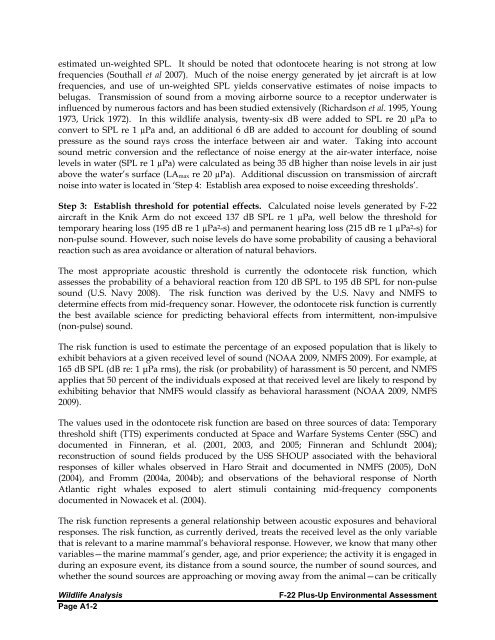F-22 Plus-Up Environmental Assessment - Joint Base Elmendorf ...
F-22 Plus-Up Environmental Assessment - Joint Base Elmendorf ...
F-22 Plus-Up Environmental Assessment - Joint Base Elmendorf ...
You also want an ePaper? Increase the reach of your titles
YUMPU automatically turns print PDFs into web optimized ePapers that Google loves.
estimated un-weighted SPL. It should be noted that odontocete hearing is not strong at low<br />
frequencies (Southall et al 2007). Much of the noise energy generated by jet aircraft is at low<br />
frequencies, and use of un-weighted SPL yields conservative estimates of noise impacts to<br />
belugas. Transmission of sound from a moving airborne source to a receptor underwater is<br />
influenced by numerous factors and has been studied extensively (Richardson et al. 1995, Young<br />
1973, Urick 1972). In this wildlife analysis, twenty-six dB were added to SPL re 20 µPa to<br />
convert to SPL re 1 µPa and, an additional 6 dB are added to account for doubling of sound<br />
pressure as the sound rays cross the interface between air and water. Taking into account<br />
sound metric conversion and the reflectance of noise energy at the air-water interface, noise<br />
levels in water (SPL re 1 µPa) were calculated as being 35 dB higher than noise levels in air just<br />
above the water’s surface (LA max re 20 µPa). Additional discussion on transmission of aircraft<br />
noise into water is located in ‘Step 4: Establish area exposed to noise exceeding thresholds’.<br />
Step 3: Establish threshold for potential effects. Calculated noise levels generated by F-<strong>22</strong><br />
aircraft in the Knik Arm do not exceed 137 dB SPL re 1 µPa, well below the threshold for<br />
temporary hearing loss (195 dB re 1 µPa 2 -s) and permanent hearing loss (215 dB re 1 µPa 2 -s) for<br />
non-pulse sound. However, such noise levels do have some probability of causing a behavioral<br />
reaction such as area avoidance or alteration of natural behaviors.<br />
The most appropriate acoustic threshold is currently the odontocete risk function, which<br />
assesses the probability of a behavioral reaction from 120 dB SPL to 195 dB SPL for non-pulse<br />
sound (U.S. Navy 2008). The risk function was derived by the U.S. Navy and NMFS to<br />
determine effects from mid-frequency sonar. However, the odontocete risk function is currently<br />
the best available science for predicting behavioral effects from intermittent, non-impulsive<br />
(non-pulse) sound.<br />
The risk function is used to estimate the percentage of an exposed population that is likely to<br />
exhibit behaviors at a given received level of sound (NOAA 2009, NMFS 2009). For example, at<br />
165 dB SPL (dB re: 1 μPa rms), the risk (or probability) of harassment is 50 percent, and NMFS<br />
applies that 50 percent of the individuals exposed at that received level are likely to respond by<br />
exhibiting behavior that NMFS would classify as behavioral harassment (NOAA 2009, NMFS<br />
2009).<br />
The values used in the odontocete risk function are based on three sources of data: Temporary<br />
threshold shift (TTS) experiments conducted at Space and Warfare Systems Center (SSC) and<br />
documented in Finneran, et al. (2001, 2003, and 2005; Finneran and Schlundt 2004);<br />
reconstruction of sound fields produced by the USS SHOUP associated with the behavioral<br />
responses of killer whales observed in Haro Strait and documented in NMFS (2005), DoN<br />
(2004), and Fromm (2004a, 2004b); and observations of the behavioral response of North<br />
Atlantic right whales exposed to alert stimuli containing mid-frequency components<br />
documented in Nowacek et al. (2004).<br />
The risk function represents a general relationship between acoustic exposures and behavioral<br />
responses. The risk function, as currently derived, treats the received level as the only variable<br />
that is relevant to a marine mammal’s behavioral response. However, we know that many other<br />
variables—the marine mammal’s gender, age, and prior experience; the activity it is engaged in<br />
during an exposure event, its distance from a sound source, the number of sound sources, and<br />
whether the sound sources are approaching or moving away from the animal—can be critically<br />
Wildlife Analysis<br />
Page A1-2<br />
F-<strong>22</strong> <strong>Plus</strong>-<strong>Up</strong> <strong>Environmental</strong> <strong>Assessment</strong>
















